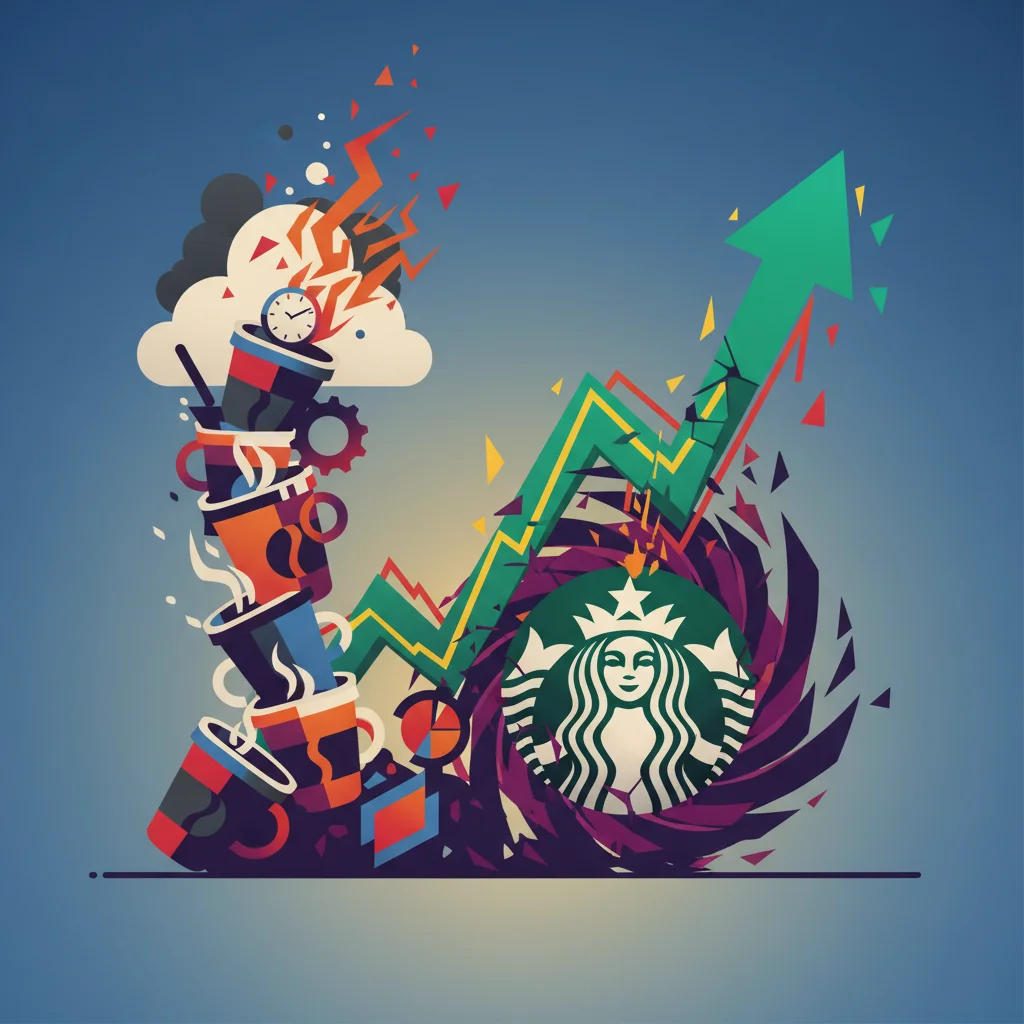
Brewing Discontent: Is Starbucks’ Labor Crisis a Ticking Time Bomb for Its Stock?
Is Starbucks’ Labor Crisis a Ticking Time Bomb for Its Stock?
CONTENT:
In the fast-paced world of the stock market, few brands are as iconic as Starbucks. For decades, the coffee giant has been a bellwether for consumer spending and a staple in countless investment portfolios. However, a storm is brewing behind the familiar green apron. As Starbucks rolls out its ambitious “Triple Shot Reinvention” strategy to reinvigorate growth, it faces a formidable challenge from within: a burgeoning union movement that could derail its recovery and redefine its future. For investors, business leaders, and anyone interested in the modern economy, the unfolding drama at Starbucks is more than just a dispute over coffee; it’s a critical case study in the clash between corporate strategy, labor rights, and long-term shareholder value.
The “Triple Shot” Strategy: A High-Stakes Bet on Efficiency
Faced with slowing sales and shifting consumer habits, Starbucks, under the leadership of CEO Laxman Narasimhan, has embarked on a comprehensive turnaround plan. Dubbed the “Triple Shot Reinvention,” the strategy is a multi-billion dollar effort to streamline operations, enhance the customer experience, and ultimately, boost the bottom line. The plan focuses on several key pillars:
- Operational Efficiency: Investing in new equipment and store layouts to speed up service, particularly for the complex cold drinks that now dominate orders. The goal is to reduce preparation times and increase throughput, directly impacting revenue per store.
- Digital Expansion: Leveraging its powerful mobile app, a prime example of successful retail fintech, to enhance customer loyalty and drive more frequent, higher-value orders.
- Store Modernization: Renovating existing locations and expanding with new formats like drive-thru-only stores to meet the demand for convenience.
From a purely financial perspective, the strategy makes perfect sense. It addresses key operational bottlenecks and aligns with post-pandemic consumer trends. The company aims to cut costs by $3 billion over three years, a figure that certainly grabs the attention of those involved in corporate finance and investing. However, this laser focus on efficiency and speed comes at a price, and it’s a price the company’s baristas are increasingly unwilling to pay.
The Great Correlation: Why Bitcoin Is Behaving Like a Tech Stock This 'Red October'
A Union Brewing: The Human Cost of Efficiency
While management focuses on optimizing workflows and shaving seconds off drink times, a grassroots movement has been gaining unprecedented momentum. The union, Starbucks Workers United, has successfully organized over 400 stores across the US since its first victory in late 2021 (source). This is not a fringe movement; it represents a fundamental disconnect between the company’s strategic goals and its employees’ on-the-ground reality.
The baristas’ grievances are not abstract. They center on chronic understaffing, unpredictable scheduling, and wages they argue haven’t kept pace with the cost of living or the increasing complexity of their jobs. The union sees the “Triple Shot” plan not as a solution, but as an accelerant to these problems. Faster service times and more complex menus, they argue, only increase the pressure on an already strained workforce without a corresponding investment in labor. This tension culminated in recent strikes, including a significant walkout on “Red Cup Day,” one of the chain’s busiest promotional events.
To better understand the fundamental conflict at the heart of Starbucks, it’s helpful to visualize the opposing priorities of management’s strategy and the union’s demands.
| Starbucks’ “Triple Shot” Focus | Starbucks Workers United’s Demands |
|---|---|
| Increase speed of service and order throughput | Guaranteed hours and consistent scheduling |
| Reduce operational costs by $3 billion | Higher wages and improved benefits |
| Enhance digital and mobile ordering efficiency | Adequate staffing to handle order volume |
| Drive shareholder value and stock performance | A seat at the table in corporate decision-making |
This table illustrates a classic corporate dilemma: the drive for operational efficiency and shareholder returns is on a direct collision course with calls for greater investment in human capital. This is a critical risk factor that any serious analysis of the company’s stock market potential must consider.
The Investor’s Dilemma: Balancing Growth and Governance
For those engaged in investing and trading, the Starbucks saga presents a complex puzzle. On one hand, a successful turnaround could lead to significant upside for the stock (SBUX). On the other, the persistent labor disputes introduce a high degree of uncertainty and risk.
Key Risks for Investors:
- Operational Disruption: Strikes, even if limited, directly impact sales and can disrupt supply chains. A nationwide, coordinated strike could have a material impact on quarterly earnings.
- Brand Erosion: Starbucks built its brand on the concept of the “third place”—a welcoming community hub between work and home. This image is fundamentally tied to its employees, or “partners.” An ongoing, public battle with those same partners threatens to tarnish this carefully crafted brand identity, potentially alienating its progressive customer base.
- Financial Costs: The direct costs of litigation and fighting unionization efforts are substantial. Furthermore, a potential contract with the union would likely lead to higher labor costs, impacting profit margins. According to a report cited by the BBC, the company has already spent hundreds of millions on legal fees and other anti-union efforts.
- Regulatory Scrutiny: The company has faced hundreds of complaints of unfair labour practices, drawing the attention of the National Labor Relations Board (NLRB). This level of regulatory scrutiny adds another layer of legal and financial risk.
This situation highlights the growing importance of ESG factors in modern financial analysis. The “S” for Social in ESG is no longer a footnote; it’s a headline risk. How a company manages its human capital is a direct indicator of its long-term viability and governance quality. The friction at Starbucks is a real-world stress test of these principles.
Beyond the Balance Sheet: The Broader Economic Context
The events at Starbucks are not happening in a vacuum. They are reflective of powerful currents in the global economics landscape. The post-pandemic era has seen a re-evaluation of essential work, tight labor markets have given employees more leverage, and a new generation of workers is showing a greater appetite for collective action. Companies from Amazon to Apple are grappling with similar unionization drives.
Furthermore, the role of financial technology in this dynamic is fascinating. The Starbucks app is a marvel of consumer engagement and a significant revenue driver. It creates a seamless, personalized experience that boosts sales. However, this same technology can exacerbate the pressures on baristas. The relentless influx of complex mobile orders during peak hours, without a corresponding adjustment in staffing models, is a major source of employee stress. It’s a poignant example of how technological innovation, if not implemented with a human-centric approach, can create significant friction within an organization.
Ultimately, the path forward for Starbucks will require more than just new espresso machines and faster drive-thrus. It will require a fundamental recalculation of the value of its workforce. The company that pioneered the idea of “partners” must now decide if it’s willing to truly partner with them at the negotiating table.
Forging the Future: Why AI and Mortgages in UK Schools is a Game-Changer for the Global Economy
For the investment community, the lesson is clear. In today’s interconnected world, a company’s relationship with its employees is inextricably linked to its financial health. The simmering conflict at Starbucks is a stark reminder that the most important ingredient in a successful business isn’t on the balance sheet or in a new piece of equipment; it’s the people who show up to work every day. Whether Starbucks can successfully integrate this human element into its “Triple Shot” strategy will determine not only the future of its recovery but also its legacy as a global corporate leader.


